These are photographs I took this morning of some of the plants blooming in our garden.
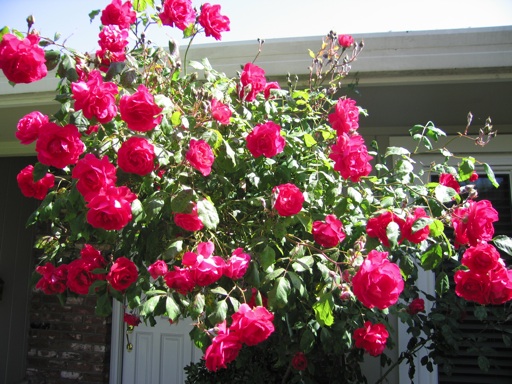
This is a photo of our Blaze climbing rose. I planted it as a bare root rose about 7 years ago. It’s so heavy with flowers and new growth right now that it’s about to fall over. I forgot to prune it last winter, which really needs to be done to reduce it’s new growth in the spring. Now I’ll either have to cut off many of it’s flowers and buds to keep it upright or add a new support to it.
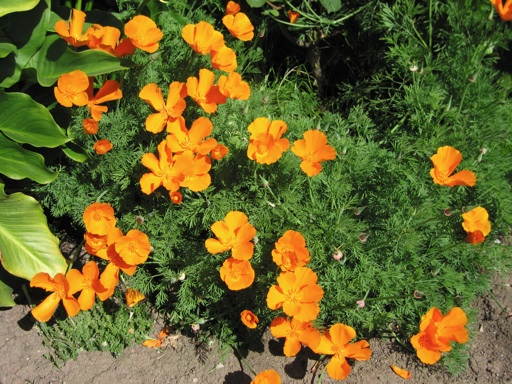
This is a photo of one of the many California poppies growing in our yard this year. I planted a California poppy transplant I bought from a nursery several years ago. A few new seedlings sprouted from that plant, but each year we had less and less of them. Last year, a few of the seedling grew and bloomed more than in the past. Those few plants must have spread their seeds widely, because this spring, poppies are growing all over our backyard. Our yard is covered with bright orange flowers, and they look amazing.
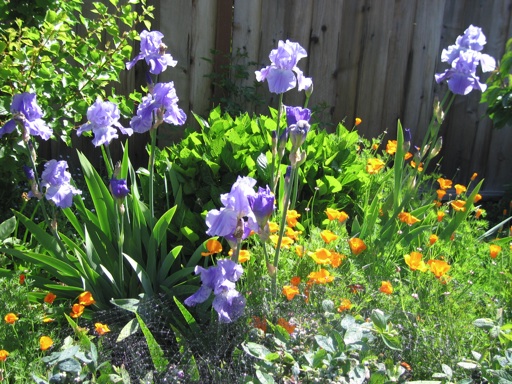
This is a photo of some lavender blue bearded irises that we’ve had in our yard for a long time. They bloomed for the first time last year, and they have even more flowers this spring. I attribute that success to the fertilizer my partner has been putting around the hydrangea that is growing behind these irises.
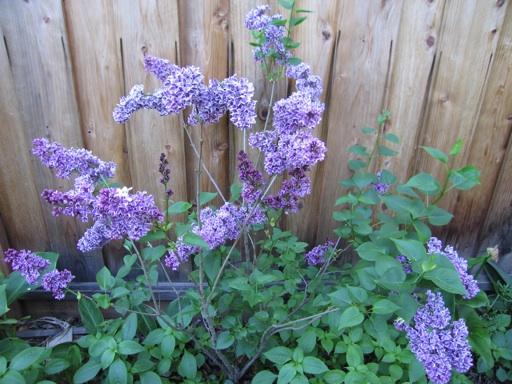
This is a photo of a Sensation lilac bush that is blooming in our yard. I bought this bush last year from a nursery, because I was enthralled by the look of the flowers, which each have a deep lavender center and a white border. This is a French hybrid lilac which is supposed to bloom best after a cold winter. Although last winter seemed chilly to me, I didn’t know until about a month ago when the buds started coming out if our climate was cold enough to stimulate this lilac to bloom. Last spring, our lilacs had very few flowers. We fertilized them with an all-purpose fertilizer 2-3 times last spring and summer to try to get them to bloom more. This spring all of our lilacs except one are covered with flowers.
April 24 2010 | California Poppies and Flowers and Irises and Lilacs and Roses | Comments Off on Still more spring flowers
These are pictures of some of the spring flowers that have been blooming in our yard the last few weeks.
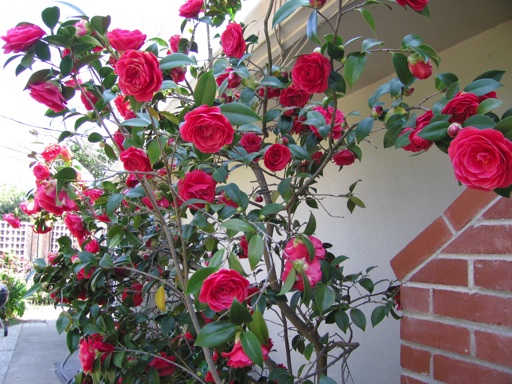
Red camelia bush.

Lavender alyogyne bushes with blue lithodora and white alyssum underneath.
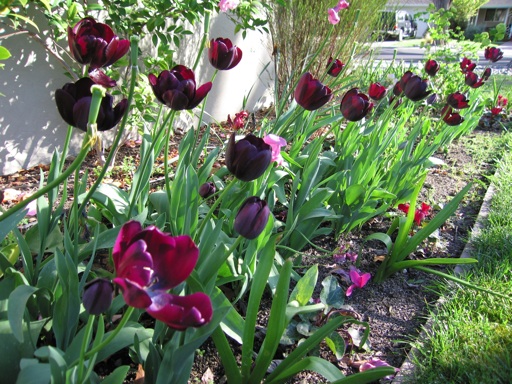
Dark purple tulips.
April 11 2010 | Alyogyne and Camellias and Lithodora and Tulips | Comments Off on More spring flowers

Blue Skies
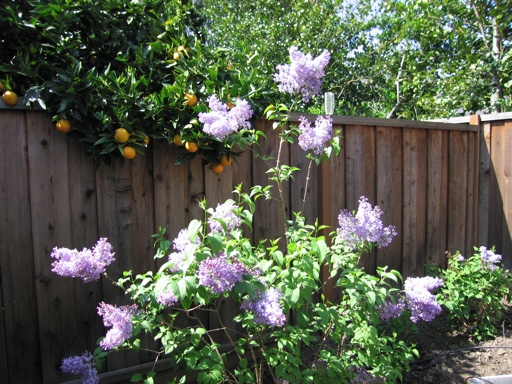
Lavender Lady
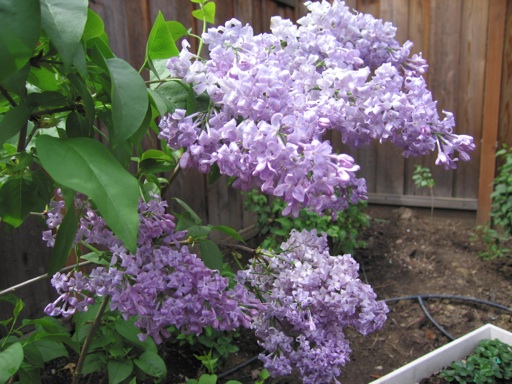
Lavender Lady flowers after a rain
Our lilac bushes have been full of flowers the past few weeks. Lilacs are among my favorite garden flowers, because they produce many large clusters of very fragrant flowers that last for weeks. They are one of the few common garden flowers that have a great flowery scent. Unfortunately, lilacs only bloom once a year.
My partner and I planted descanso hybrid lilacs that were developed for mild winter climates. We have three of the Lavender Lady variety, one of the Blue Skies variety, and one of the California Rose variety, which are all lavender in color. This year our Lavender Lady and Blue Skies bushes are coming into bloom with many more flowers than in previous years. I think they are blooming so much this year, because we took the time to fertilize them two or three times last summer. Although, our California Rose lilac has only two small clusters of flower buds on it. But that could be because it is growing in a dry spot next to our house where it doesn’t get much sunlight.
Our oldest Lavender Lady lilac has produced offshoots that are rooting near the base of the plant. My partner dug up one, and it was full of roots so he transplanted it to grow into a new bush. It seems to have taken to the transplant well so far. We plan on digging up more of the offshoots to get even more lilacs. My mom transplanted an offshoot from her white lilac a few years ago, and it has already grown into a medium size bush that is full of flowers. I am not sure if the lilacs we planted were grafted, but they don’t look like they were grafted. Obviously, if they were grafted onto the rootstock of different variety, then the offshoots won’t be genetically the same as Lavender Lady.
We also planted one Sensation lilac, which has a deep purple color fringed with white. Our Sensation lilac is full of buds that haven’t opened yet, even though Sensation is not a Descanso hybrid and is supposed to require a more pronounced winter chill to stimulate bloom.
March 30 2010 | Lilacs | Comments Off on Lilacs in Bloom
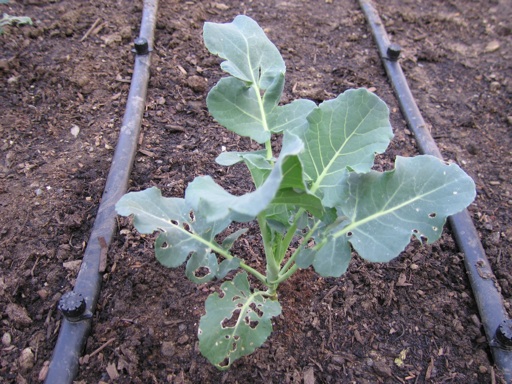
For years, I have attempted to keep snails and slugs away from my strawberry and vegetable plants using 1″ thick copper tape barriers. I have copper tape barriers around all of my strawberry pots and my raised vegetable garden beds. However, I have continued to find many slugs and the occasional snail in my strawberry pots and raised beds. Slugs in particular have been munching on our broccoli plants in the past few weeks, as you can see in the above picture.
The copper tape hasn’t deterred the slugs at all and has not entirely deterred the snails. The copper tape has tarnished since I put it on, which may have reduced its effectiveness. But I am not convinced that repeatedly applying new copper or cleaning the old copper is worth the cost and effort. I have also tried using snail baits in the past, but they have just washed away after repeated waterings and need to be reapplied too often.
I have recently resorted to hand picking snails and slugs out of our garden. It’s especially easy to remove them by hand this time of year, because our vegetable garden is not completely planted yet, and the plants we have set out so far are still small. Snails and slugs move out of their daytime hiding places after dark and are easier to locate then. So I have been going out into our yard a few hours after dark several nights a week with a flashlight to remove all of the snails and slugs I can find. I think that I have reduced the population substantially for now, because I have not seen any more damage to our broccoli or to the tomatoes and peppers I just planted.
Hand removal may be the most labor intensive way to deal with snails and slugs. However, I am beginning to think that hand removal combined with reducing the number of places they can hide to make the yard a less conducive place for them to live is perhaps the best overall solution to dealing with snails and slugs. Snails and slugs like to hide in moist and/or dark places in the daytime. Slugs tend to hide under pots in our yard where it remains moist all the time. The snails tend to hide in lilies such as callas, day lilies, and lilies of the nile, as well as other bushy moist plants that have low hanging leaves. I have removed most of the day lilies and all of the lilies of the nile we used to have. I also pulled up many of our callas, but the ones I left in the ground have proliferated. I am also thinking about reducing the number of pots in our yard.
Going forward, I plan on continuing to perform the hand removal technique after dark once or twice a week. I am hoping that this frequency will be enough to keep the population in check. In the past, I have basically relied on some technical solution to solve the problem for me without much follow up on my part. But I am now realizing that these pests require more involvement by a gardener actively monitoring growing plants for pest damage and taking steps to mitigate the damage as soon as it is discovered.
March 25 2010 | Garden Pests and Vegetables | Comments Off on Snails and Slugs
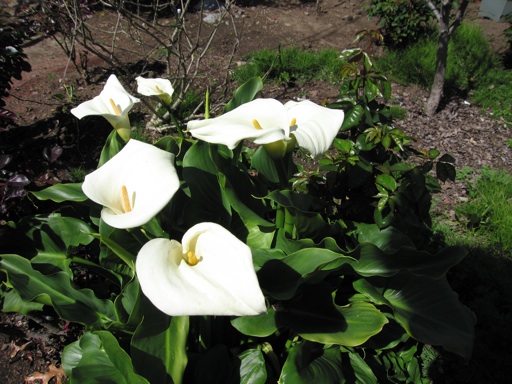
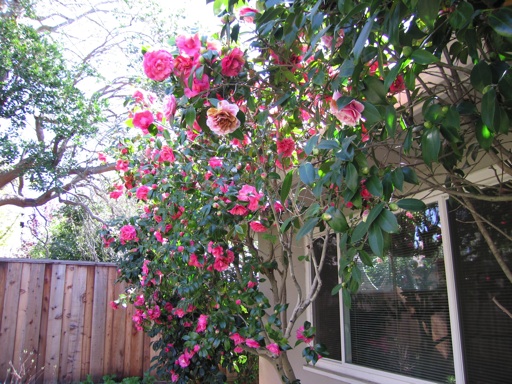
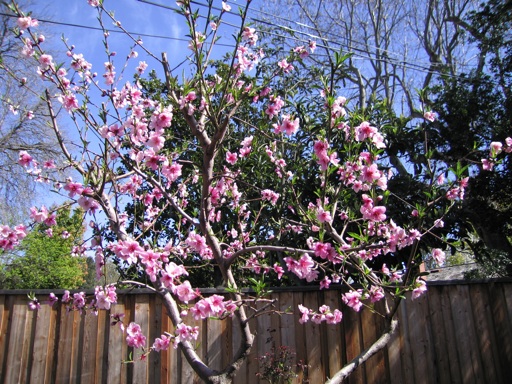
The vernal equinox occurred this morning at 10:32 am PDT, but spring flowers have been blooming in our yard for several weeks now. The first picture shows some of the many white calla lilies that are blooming in our backyard this month. After planting them all over our backyard for years, I started to remove many of them last year, because they are a favorite hiding place for snails. Despite my attempts to reduce their numbers, the remaining calla bulbs have multiplied and are as numerous as ever. Callas seem to thrive on lots of water, and the plentiful rainfall we received this winter has caused them to grow and flower prolifically in the past few weeks.
The second picture shows three pink camelia bushes that are blooming in our backyard. These camelia bushes, which are very established and probably decades old, produce an abundance of flowers every winter and spring without requiring much care. They are among my favorite of the plants in our backyard. However, they do make a big mess when they drop their numerous flowers on the ground.
The third picture shows our O’Henry peach tree in bloom. We have four peach and nectarine trees, and all of them produce pink flowers. Our peaches and nectarines (and almond tree) are the only fruit trees we are growing that have pink flowers. The rest of our fruit trees (apricot, plum, cherry, apple, orange, and pear) have white blossoms. The O’Henry blossoms are particularly long lasting. This tree has been covered with blossoms for over two weeks now.
March 20 2010 | Camellias and Flowers and Peaches/Nectarines | Comments Off on Spring Blooms
« Prev - Next »













